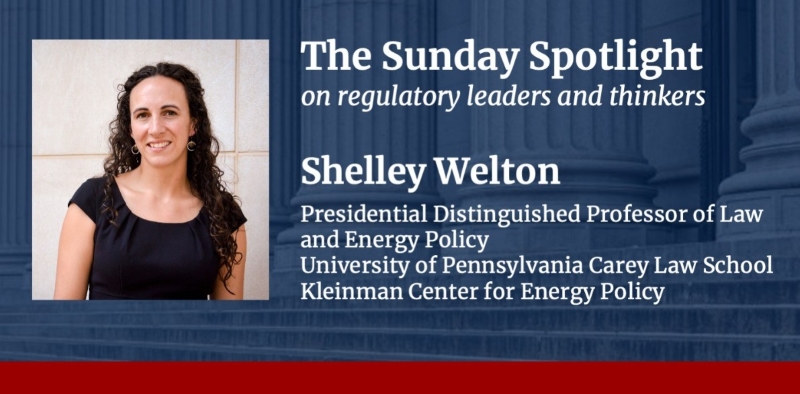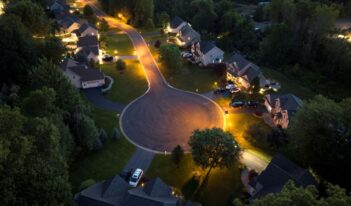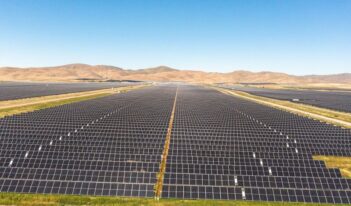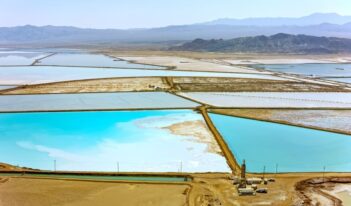
Shelley Welton discusses how a comprehensive regulatory strategy for electric grid reliability can facilitate a transition to clean energy.
In a recent conversation with The Regulatory Review, energy law and policy scholar Shelley Welton discusses how clean energy sources can be harnessed to improve the stability of the electric grid. This transition would also ensure that the United States meets its grid decarbonization goals to help combat climate change.
Climate change continues to threaten the U.S. electric grid. One analysis found that the average number of weather-related power outages has increased since 2012. In addition, strong indicators—including the growth of artificial intelligence and manufacturing—suggest that electric demands will continue to grow. Welton explains how regulators struggle to maintain the grid while juggling changes in the electric grid’s resource composition, demand growth, and the increasing frequency of natural disasters.
Clean energy offers a potential solution, especially given recent natural gas-powered failures. Welton argues that well-designed grid governance laws and institutions can ensure that clean energy improves the reliability of the grid by enabling local energy solutions and expanding the transmission grid.
This transition, Welton notes, will require significant reforms to ensure that energy decision-makers are properly regulated and prompted to use clean energy. Welton is optimistic, however, that a coordinated effort by local, regional, and federal institutions can support the necessary reforms to reinvent the U.S. energy grid and improve grid reliability while addressing climate change.
Welton is the Presidential Distinguished Professor of Law and Energy Policy at University of Pennsylvania Carey Law School. She is an affiliated faculty member with the Penn Program on Regulation and a faculty fellow at Penn’s Environmental Innovations Initiative. She previously taught at University of South Carolina Joseph F. Rice School of Law and holds a Ph.D. in law from Yale Law School, where her dissertation evaluated how climate change is reshaping U.S. energy law.
The Regulatory Review is pleased to share the following interview with Professor Shelley Welton.
The Regulatory Review: What are some of the challenges that regulators deal with today in maintaining a stable electricity grid?
Welton: There are distinct pressures coming from three directions. First, the resource composition of the electricity system is—thankfully!—changing. Coal plants are rapidly retiring, while renewable resources are lining up to connect to the grid much faster than can be accommodated. This shifting resource mix creates new challenges for grid managers because wind and solar power are weather-dependent resources and require different solutions for reliability than did the old, predominantly fossil-fuel-based resource mix.
Second, electrification, manufacturing growth, and growing data demands—largely AI-related—are necessitating grid expansion at a far more rapid clip than has been accomplished in the last fifty years.
Finally, climate-change-fueled disasters test grid managers, as storms and fires put severe and increasing stress upon grid reliability and resiliency.
TRR: You coauthored an article arguing that reforms are necessary to improve the reliability of the electricity grid. Can you describe some of the most important reforms?
Welton: It took 90 pages to describe these reforms in the article, so this is a real test! In brief, we need regulators who are enthusiastic about tackling evolving grid reliability challenges and have the jurisdictional bandwidth to do so. At present, our regulators too often perceive renewable energy as a threat rather than an opportunity and lack the whole-system perspective or legal authority necessary to design and build the grid of the future.
TRR: A significant part of the complexity around electricity grid regulation is the need to transition to clean energy sources due to climate change. Can you explain some of these complexities?
Welton: A growing number of states have set targets for decarbonizing the electricity sector entirely by as soon as 2035—a goal in line with scientific imperatives for climate mitigation and one that the Biden Administration has shared. That’s an incredibly tall ask! It involves building and interconnecting huge amounts of new renewable energy, energy storage, and additional dispatchable resources—including new nuclear power, hydrogen-fueled power, long-duration energy storage, and carbon capture and storage. It also will require doubling or tripling the size of the transmission grid and building considerably more long-distance, high-voltage lines than we do at present.
Altogether, the clean energy transition is an enormous infrastructural challenge—and we’re not yet rising to the task. But I think it is important to emphasize that, at this point, this is much more a policy and governance challenge than a technical one. We mostly know what we need to build and how to build it. Yet projects are stuck in five-year interconnection queues, local opposition to siting clean energy infrastructure is rising, and utilities are not collaborating to build the transmission system we need. It will require significant efforts by local, state, regional, and federal institutions to make the kinds of governance changes necessary to support this transition—but I think it can be done.
TRR: You have argued that a decarbonized grid could be more reliable. How so?
Welton: The best way to affordably and reliably integrate large amounts of clean energy is to significantly expand the size of the transmission grid, making it much more resilient in the face of regional disruptions and climate disasters. A decarbonized system that emphasizes local energy solutions—such as microgrids and community energy—as complementary strategies could provide backup sources of power to communities during reliability events.
Another facet of this argument is that natural gas generation—the primary fossil fuel powering our energy system—has failed repeatedly in recent major storms, suggesting that a non-decarbonized grid is less reliable than many assume under changing climate conditions.
Finally, to zoom out to geopolitics, if the United States cannot muster the political will and technological savvy to decarbonize our energy system, then it is unlikely that many other countries will. So, without leading grid decarbonization efforts, we will likely face climactic conditions that make maintaining grid reliability increasingly expensive and untenable.
TRR: What role do regional transmission organizations (RTOs) play in transitioning to a decarbonized energy system?
Welton: In most of the country, RTOs operate the transmission grid, manage electricity markets, and plan future grid expansions—all under Federal Energy Regulatory Commission (FERC) oversight. These entities, which are essentially membership organizations, thus make many of the most critical decisions influencing decarbonization in their regions: how new resources interconnect to the system; where transmission lines get built; and what kinds of resources are eligible to participate in various energy markets.
TRR: Do you have any recommendations for regulatory changes to ensure that RTOs are properly enabled to use clean energy?
Welton: Boy, do I! My biggest recommendation is a structural overhaul. I do not think it makes sense to delegate decision-making on all the critical topics listed above to what are essentially private membership clubs comprised mostly of industry incumbents. These incumbents naturally have interests misaligned with a rapid clean energy transition, and we see them wield their authority within RTOs to block or slow many efficacious reforms.
Thus, I would like to see FERC exercise more authority to regulate RTOs—and utilities more generally—in the public interest by forcing them to engage in forward-looking planning and reforms that treat clean energy fairly and facilitate building the grid of the future at the lowest possible cost to consumers.
TRR: On a personal note, what drew you to studying energy regulation, and what advice would you offer students or prospective students who are interested in this area of regulation?
Welton: I always thought I was gearing up for a career in environmental law. I came to energy through climate change, and I came to climate change through a love of time spent outdoors in the backcountry. But I am now firmly a scholar of energy governance because, quite simply, this is where so much of the exciting intellectual and practical work to be done on climate change exists.
I think my curvy path into energy law is indicative of the advice I frequently offer: there are many roads to a meaningful career, and most of them don’t have only one stop along the way. Being open to pursuing your passions in whatever forms offer themselves up can often open doors or trajectories that you previously wouldn’t have even known would be a great fit.



